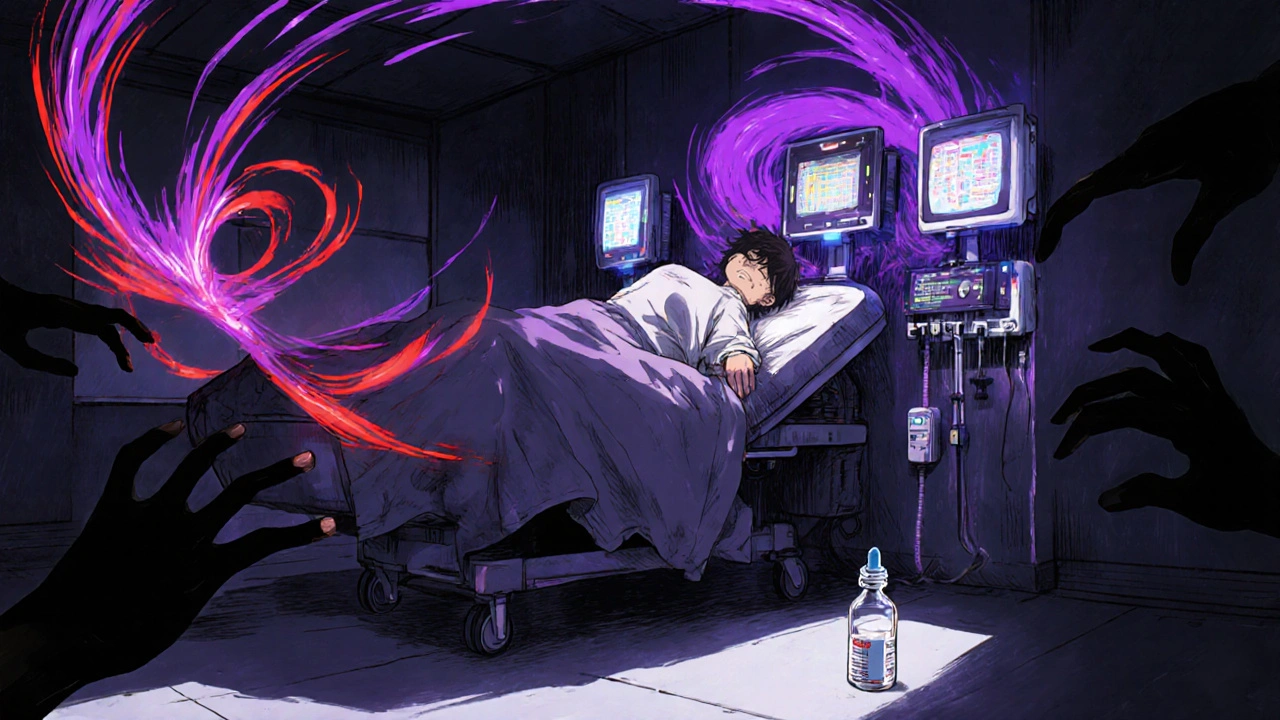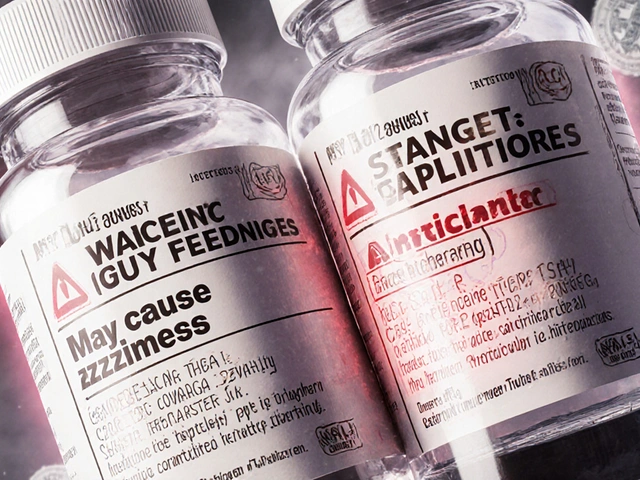It starts with a cold. A stuffy nose, a scratchy throat, and a cough that won’t quit. You grab a bottle of cough syrup from the pharmacy shelf-no prescription needed. The label says dextromethorphan (DXM), and it’s supposed to quiet your cough. But for some, especially teens and young adults, that little bottle isn’t medicine anymore. It’s a shortcut to another world.
What DXM Is (And What It’s Not)
Dextromethorphan is a synthetic drug designed to block the cough reflex in your brain. It’s not a painkiller. It’s not addictive when used as directed. It’s been in over-the-counter cold meds since the 1950s, and for decades, it worked exactly as intended: safe, effective, and harmless at normal doses.
But here’s the twist: when you take way more than the label says-like 10, 20, or even 50 times the recommended amount-DXM stops being a cough suppressant. It turns into a dissociative hallucinogen. That’s when things get dangerous. At high doses, it mimics the effects of PCP or ketamine: you feel detached from your body, your vision blurs, sounds warp, and time slows down. Some users call this “robo tripping” or “dexing.”
How People Abuse It
Abuse doesn’t happen with one sip. It takes bottles. A single dose of DXM for a cough is 15-30 mg. Abusers often swallow 240 mg to 1,500 mg at once. That’s not just over the limit-it’s a full-blown overdose.
Here’s how it usually goes down:
- People buy multiple bottles of cough syrup-brands like Robitussin DM, NyQuil, Coricidin, or Dimetapp DM. The “DM” on the label means it contains dextromethorphan.
- They drink the whole bottle, or several, in one sitting. Some mix it with soda or candy to mask the awful taste.
- Others do something called a “robo shake”: drink a ton of syrup, then make themselves throw up. The goal? Keep the DXM in their system while getting rid of the sugar, alcohol, and other junk that causes nausea.
- More advanced users extract pure DXM powder from the syrup using chemicals they find online. They then swallow it, snort it, or even inject it. This is where the risk skyrockets.
These methods aren’t myths. They’re documented in DEA reports, hospital case studies, and treatment center logs. Websites still exist that give step-by-step instructions on how to isolate DXM. And it’s not hard to find. You can buy pure DXM powder on the internet under names like “C-C-C” or “Red Devils.”
The Plateaus: What Happens at Different Doses
DXM doesn’t just make you feel “high.” It creates distinct experiences based on how much you take. These are called “plateaus.”
- First plateau (100-200 mg): Mild euphoria, slight dizziness, warmth. You might feel like you’ve had a few drinks.
- Second plateau (200-400 mg): Distorted vision, numbness, time feels stretched. You might feel detached from your body.
- Third plateau (400-600 mg): Hallucinations, out-of-body experiences, confusion. You might not recognize your own voice or surroundings.
- Fourth plateau (600+ mg): Complete dissociation. You’re not just high-you’re out. You can’t move, speak, or think clearly. This is where people end up in the ER, or worse.
At the highest levels, users report feeling like they’re floating, watching themselves from above. Some describe it as spiritual. Others say it’s terrifying. Either way, your body is under serious stress.

The Physical Risks
DXM isn’t harmless just because it’s legal. At high doses, it can wreck your body.
- Heart problems: Fast or irregular heartbeat, dangerously high blood pressure.
- Neurological damage: Seizures, brain swelling, permanent cognitive issues.
- Overdose: Vomiting, extreme drowsiness, coma, stopped breathing.
- Death: Especially when mixed with alcohol, acetaminophen (found in many cold meds), or stimulants like MDMA.
One study found that combining DXM with alcohol increases the risk of fatal liver damage. Why? Because many cough syrups already contain acetaminophen. Take too much DXM, and you’re also taking too much Tylenol. That’s a deadly combo.
Mount Sinai Health System reports that overdose cases are rising. Survival depends on how fast you get to the hospital. But many users don’t call for help-they’re too disoriented, or they’re afraid of getting in trouble.
Why Teens Are Drawn to It
It’s cheap. It’s easy. It’s everywhere.
You don’t need to know a dealer. You don’t need cash for a black market. You just need a wallet and a pharmacy. A bottle of Robitussin DM costs less than $10. A bag of pure DXM powder online? Around $20. Compare that to marijuana, ecstasy, or even prescription pills. DXM is the cheapest high on the market.
And it’s marketed as “safe” because it’s OTC. Teens hear, “It’s just cough medicine,” and assume it’s harmless. But the truth is, the FDA approved it for coughs-not for getting high. The same bottle that helps your grandma sleep through the night can send a 16-year-old to the ICU.
According to the National Institute on Drug Abuse, about 3% of teens admit to abusing DXM. That’s 1 in 30. And those numbers have been climbing since 2015.
Is DXM Addictive?
This is where experts disagree. The New Mexico Department of Health says DXM isn’t addictive. But treatment centers like Greenhouse Treatment say otherwise. They’re seeing patients who crave it, can’t stop using it, and go through withdrawal symptoms like anxiety, insomnia, and cravings.
It’s not like heroin or cocaine. You won’t get needle tracks or tremors. But your brain adapts. You need more to get the same effect. You start skipping school, lying to parents, hiding bottles. That’s addiction-even if it’s not physical dependence in the classic sense.

What’s Being Done
Pharmaceutical companies have tried to fight back. Some now put DXM behind the counter. Others add bittering agents to make it taste awful. Some states have passed laws limiting how much you can buy at once.
But the real problem isn’t regulation-it’s awareness. Most parents don’t know what “DM” means on a bottle. Most teens don’t realize they’re taking a powerful hallucinogen.
Organizations like the Consumer Healthcare Products Association (CHPA) are working with schools and health departments to spread the word. But the message still isn’t getting through.
What to Look For
If you’re worried about someone-your child, a friend, a sibling-here are signs:
- Empty cough syrup bottles in the trash or bedroom
- Unexplained drowsiness, confusion, or slurred speech
- Blurred vision or poor coordination
- Sudden interest in online forums about “robo tripping”
- Secretive behavior, mood swings, declining grades
- Smell of cough syrup on breath or clothes
And if you see someone taking a whole bottle? Don’t wait. Call 911. Every minute counts.
The Bottom Line
DXM isn’t a joke. It’s not a rite of passage. It’s a powerful drug that, when misused, can kill. The same medicine that helps you breathe easier can trap you in a nightmare you can’t wake up from.
Legally available doesn’t mean safe. Just because you can buy it without a prescription doesn’t mean you should take more than the label says.
If you’re using DXM to escape, to feel something, to get high-there are better ways. Talk to someone. Get help. Because once you cross that line, you might not be able to find your way back.
Can you get addicted to DXM from cough syrup?
Yes. While DXM isn’t physically addictive like opioids, repeated high-dose use can lead to psychological dependence. People start needing more to feel the same effects, lie about their use, and prioritize it over school, work, or relationships. Treatment centers report increasing cases of DXM dependency, especially among teens and young adults.
Is DXM abuse only a problem for teens?
No. While teens are the most common group, adults-including college students and young professionals-are also abusing DXM. The reasons vary: curiosity, self-medication for anxiety, or a desire to escape reality. The risks are the same regardless of age.
What brands contain DXM?
Common brands include Robitussin DM, NyQuil, DayQuil, Coricidin, Dimetapp DM, Triaminic DM, Benylin DM, Drixoral, TheraFlu, and St. Joseph Cough Suppressant. Look for “DM,” “Cough Suppressant,” or “Tuss” on the label. Some products also combine DXM with acetaminophen or alcohol, which increases the danger.
Can you overdose on DXM powder?
Yes, and it’s far more dangerous than syrup. Pure DXM powder is concentrated and easy to misjudge. A tiny amount too much can cause seizures, coma, or death. Snorting or injecting it raises the risk of overdose even further. There’s no safety margin-just one wrong dose can be fatal.
What should I do if someone I know is abusing DXM?
Don’t ignore it. Talk to them calmly, without judgment. If they’re in immediate danger-unconscious, having seizures, or having trouble breathing-call emergency services right away. For ongoing abuse, connect them with a counselor or addiction specialist. Organizations like SAMHSA offer free, confidential support. Early intervention can prevent long-term harm.
Is DXM legal?
Yes, as long as it’s used as directed on the label. But selling or distributing pure DXM powder without a license is illegal in many places. Some states have started restricting how much DXM you can buy at once. The DEA is monitoring abuse trends and could classify DXM as a controlled substance if usage continues to rise.
How long do DXM effects last?
The effects can last anywhere from 4 to 8 hours, depending on the dose and whether it’s taken with food or other substances. The peak usually happens 2-3 hours after ingestion. But the after-effects-confusion, fatigue, nausea-can linger for a full day or longer. Some users report depression or anxiety for days after.







Alex Dubrovin
November 25, 2025 AT 13:07